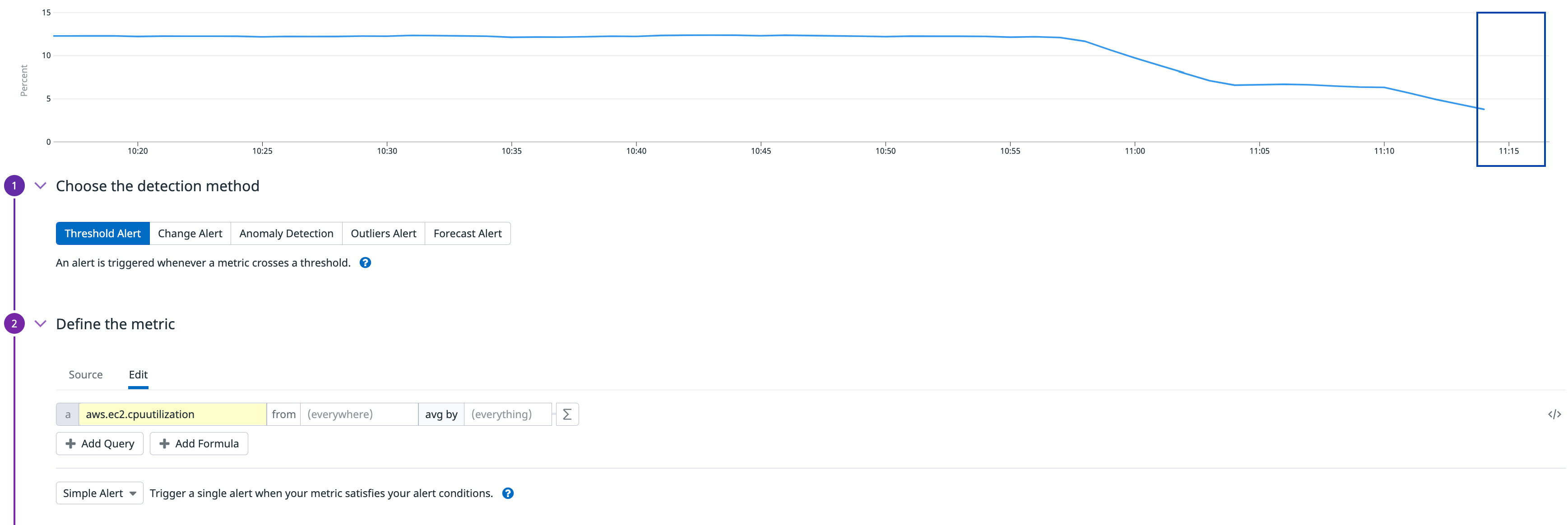- Essentials
- Getting Started
- Agent
- API
- APM Tracing
- Containers
- Dashboards
- Database Monitoring
- Datadog
- Datadog Site
- DevSecOps
- Incident Management
- Integrations
- Internal Developer Portal
- Logs
- Monitors
- OpenTelemetry
- Profiler
- Session Replay
- Security
- Serverless for AWS Lambda
- Software Delivery
- Synthetic Monitoring and Testing
- Tags
- Workflow Automation
- Learning Center
- Support
- Glossary
- Standard Attributes
- Guides
- Agent
- Integrations
- Developers
- Authorization
- DogStatsD
- Custom Checks
- Integrations
- Create an Agent-based Integration
- Create an API Integration
- Create a Log Pipeline
- Integration Assets Reference
- Build a Marketplace Offering
- Create a Tile
- Create an Integration Dashboard
- Create a Monitor Template
- Create a Cloud SIEM Detection Rule
- OAuth for Integrations
- Install Agent Integration Developer Tool
- Service Checks
- IDE Plugins
- Community
- Guides
- OpenTelemetry
- Administrator's Guide
- API
- Partners
- Datadog Mobile App
- DDSQL Reference
- CoScreen
- CoTerm
- Cloudcraft (Standalone)
- In The App
- Dashboards
- Notebooks
- DDSQL Editor
- Reference Tables
- Sheets
- Monitors and Alerting
- Metrics
- Watchdog
- Bits AI
- Internal Developer Portal
- Error Tracking
- Change Tracking
- Service Management
- Actions & Remediations
- Infrastructure
- Cloudcraft
- Resource Catalog
- Universal Service Monitoring
- Hosts
- Containers
- Processes
- Serverless
- Network Monitoring
- Cloud Cost
- Application Performance
- APM
- APM Terms and Concepts
- Application Instrumentation
- APM Metrics Collection
- Trace Pipeline Configuration
- Correlate Traces with Other Telemetry
- Trace Explorer
- Recommendations
- Code Origins for Spans
- Service Observability
- Endpoint Observability
- Dynamic Instrumentation
- Live Debugger
- Error Tracking
- Data Security
- Guides
- Troubleshooting
- Continuous Profiler
- Database Monitoring
- Agent Integration Overhead
- Setup Architectures
- Setting Up Postgres
- Setting Up MySQL
- Setting Up SQL Server
- Setting Up Oracle
- Setting Up Amazon DocumentDB
- Setting Up MongoDB
- Connecting DBM and Traces
- Data Collected
- Exploring Database Hosts
- Exploring Query Metrics
- Exploring Query Samples
- Exploring Database Schemas
- Exploring Recommendations
- Troubleshooting
- Guides
- Data Streams Monitoring
- Data Jobs Monitoring
- Data Observability
- Digital Experience
- Real User Monitoring
- Synthetic Testing and Monitoring
- Continuous Testing
- Product Analytics
- Software Delivery
- CI Visibility
- CD Visibility
- Deployment Gates
- Test Optimization
- Quality Gates
- DORA Metrics
- Security
- Security Overview
- Cloud SIEM
- Code Security
- Cloud Security
- App and API Protection
- Workload Protection
- Sensitive Data Scanner
- AI Observability
- Log Management
- Observability Pipelines
- Log Management
- Administration
Adjusting No Data alerts for metric Monitors
No Data Alerts are a great way to be notified when an Integration/application is no longer submitting metrics to Datadog. When utilizing a Metric Monitor for a metric that isn’t always reported at the same frequency or is reported with a timestamp slightly in the past, such as a metric from the AWS Integration, you may receive No Data alerts despite seeing these values in Datadog. There are a couple Monitor configuration options that can be edited to properly evaluate over these types of metrics:
- The image above displays that this metric:
aws.ec2.cpuutilizationis coming in with a slight delay. This is due to the limitations on how soon this metric is available from Cloudwatch.
Delay Evaluation option. Since Monitors perform an evaluation every minute, it is looking back on the past X minutes of data. For backfilled metrics, like those coming from AWS, the monitor may be looking at a period of time when the data is not in Datadog. This causes false No Data alerts. Setting this field allows you to have the monitor wait, 900 seconds, so that the AWS metrics have 900 seconds to be available within Datadog before the monitor begins evaluation.
This option is the Require a Full Window of Data (or the ability to not require). This option is typically recommended for metrics being reported by the Datadog Agent and ones that are coming in with the current timestamp. For slightly backfilled metrics, this option can cause No Data events or have the Monitor skip the current evaluation period due to the values not being present at the time the monitor evaluates. For this reason all sparse metrics or metrics that don’t report at the same frequency should keep the default option “Do Not Require a Full Window of Data”.
Lastly, when building effective monitors, it is important to understand these limitations. Cloud Metric delays are different for each cloud provider. To receive metrics with significant smaller delay, install the Datadog Agent on your cloud hosts when possible. Refer to the documentation on installing the Datadog Agent on your cloud instances.
Contact us should you experience any issues.
Additional helpful documentation, links, and articles:


